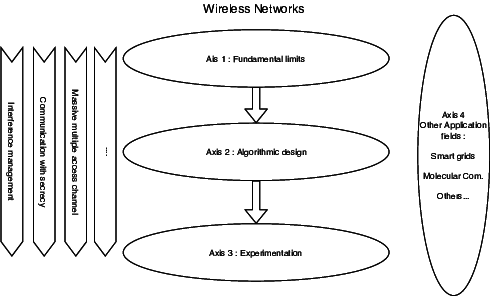Section: Research Program
Research program
Our research is organized in 4 research axes:
-
Axis 1 - Fundamental Limits of Reliable Communication Systems: Information theory is revisited to integrate reliability in the wide sense. The non-asymptotic theory which made progress recently and attracted a lot of interest in the information theory community is a good starting point. But for addressing computing network in a wide sense, it is necessary to go back to the foundation of communication theory and to derive new results, e.g. for non Gaussian channels [8] of for multi-constrained systems [17].
This also means revisiting the fundamental estimation-detection problem [65] in a general multi-criteria, multi-user framework to derive tractable and meaningful bounds.
As mentioned in the introduction, Computing Networks also relies on a data-centric vision, where transmission, storage and processing are jointly optimized. The strategy of caching at the edge [57] proposed for cellular networks shows the high potential of considering simultaneously data and network properties. Maracas is willing to extend his skills on source coding aspects to tackle with a data-oriented modeling of Computing Networks.
-
Axis 2 - Algorithms and protocols: Our second objective is to elaborate new algorithms and protocols able to achieve or at least to approach the aforementioned fundamental limits. While the exploration of fundamental limits is helpful to determine the most promising strategies (e.g. relaying, cooperation, interference alignment) to increase system performance, the transformation of these degrees of freedom into real protocols is a non trivial issue. One reason is the exponentially growing complexity of multi-user communication strategies, with the number of users, due to the necessity of some coordination, feedback and signaling. The general problem is a decentralized and dynamic multi-agents multi-criteria optimization problem and the general formulation is a non-linear and non-convex large scale problem.
The conventional research direction aims at reducing the complexity by relaxing some constraints or by reducing the number of degrees of freedom. For instance, topology interference management is a seducing model used to reduce feedback needs in decentralized wireless networks leading to original and efficient algorithms [67], [59].
Another emerging research direction relies on using machine learning techniques [54] as a natural evolution of cognitive radio based approaches. Machine learning in the wide sense is not new in radio networks, but the most important works in the past were devoted to reinforcement learning approaches. The use of deep learning (DL) is much more recent, with two important issues : i) identifying the right problems that really need DL algorithms and ii) providing extensive data sets from simulation and real experiments. Our group started to work on this topic in association with Nokia in the joint research lab. As we are not currently expert in deep learning, our primary objective is to identify the strategic problems and to collaborate in the future with Inria experts in DL, and in the long term to contribute not only to the application of these techniques, but also to improve their design according to the constraints of computing networks.
-
Axis 3 - Experimental validation : With the rapid evolution of network technologies, and their increasing complexity, experimental validation is necessary for two reasons: to get data, and to validate new algorithms on real systems.
Maracas activity leverages on the FIT/CorteXlab platform (http://www.cortexlab.fr/), and our strong partnerships with leading industry including Nokia Bell Labs, Orange labs, Sigfox or Sequans. Beyond the platform itself which offers a worldwide unique and remotely accessible testbed , Maracas also develops original experimentations exploiting the reproducibility, the remote accessibility, and the deployment facilities to produce original results at the interface of academic and industrial research [1], [10]. FIT/CorteXlab uses the GNU Radio environment to evaluate new multi-user communication systems.
Our experimental work is developed in collaboration with other Inria teams especially in the Rhone-Alpes centre but also in the context of the future SILECS project https://www.silecs.net/ which will implement the convergence between FIT and Grid'5000 infrastructures in France, in cooperation with European partners and infrastructures. SILECS is a unique framework which will allow us to test our algorithms, to generate data, as required to develop a data-centric approach for computing networks.
Last but not least, software radio technologies are leaving the confidentiality of research laboratories and are made available to a wide public market with cheap (few euros) programmable equipment, allowing to setup non standard radio systems. The existence of home-made and non official radio systems with legacy ones could prejudice the deployment of Internet of things. Developing efficient algorithms able to detect, analyse and control the spectrum usage is an important issue. Our research on FIT/CorteXlab will contribute to this know-how.
-
Axis 4 - Other application fields : Even if the wireless network context is still challenging and provides interesting problems, Maracas targets to broaden its exploratory playground from an application perspective. We are looking for new communication systems, or simply other multi-user decentralized systems, for which the theory developed in the context of wireless networks can be useful. Basically, Maracas might address any problem where multi-agents are trying to optimize their common behavior and where the communication performance is critical (e.g. vehicular communications, multi-robots systems, cyberphysical systems). Following this objective, we already studied the problem of missing data recovery in smart grids [11] and the original paradigm of molecular communications [6].
Of course, the objective of this axis is not to address random topics but to exploit our scientific background on new problems, in collaboration with other academic teams or industry. This is a winning strategy to develop new partnerships, in collaboration with other Inria teams.



